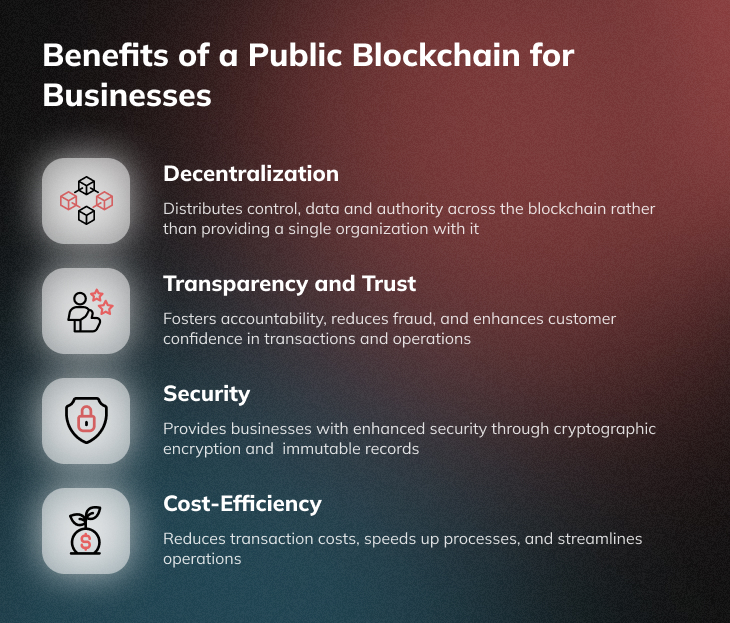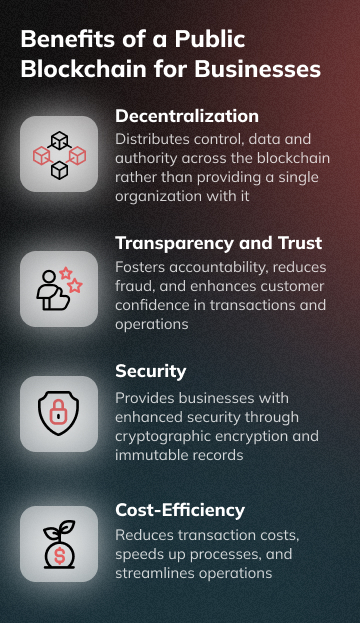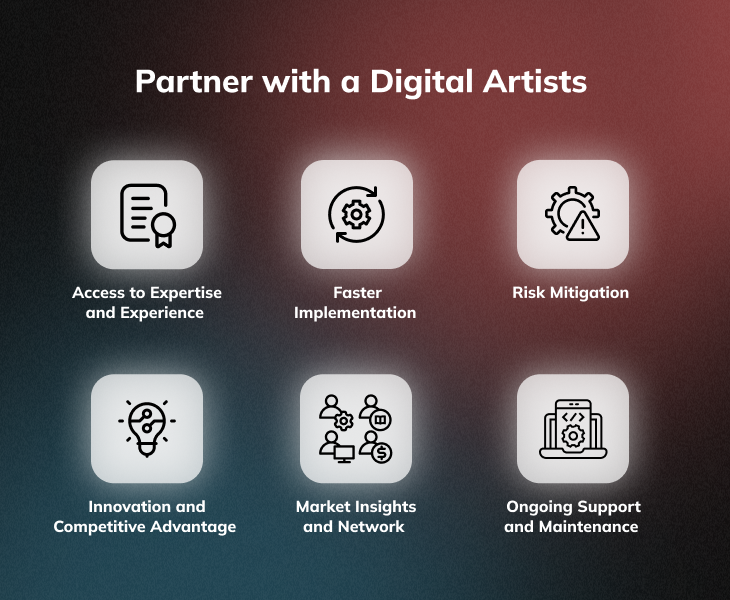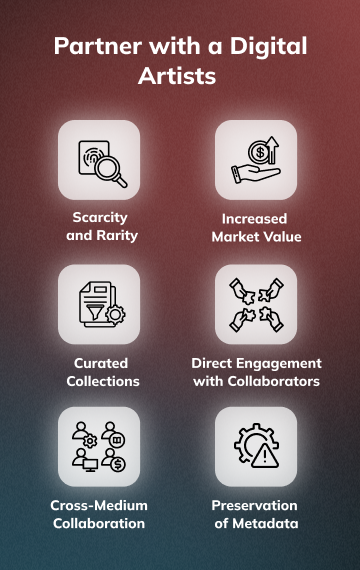


Businesses are becoming more and more interested in the transformative potential of Web3 for their daily operations. The allure lies in the decentralized nature of public blockchain, fostering trust, transparency, and security. Embracing Web3 is a strategic move, offering an innovative foundation for businesses wishing to expand into a realm of new possibilities.
While aiming for success through blockchain technology, businesses must pay attention to small details before integrating this innovation into their daily operations. It’s crucial to ask and answer the most pertinent questions while delving into these specifics. Among various blockchain types, the one most suitable for businesses often turns out to be the decentralized, public variety.
With the rapid evolution of digital innovation, the business world is increasingly recognizing and seeking out the transformative potential of these decentralized systems. There’s a growing demand for secure, decentralized solutions, and it’s in this context that blockchains with open access are emerging as a key technology. They offer a range of benefits from unalterable record-keeping to smart contract functionality, presenting opportunities that go beyond traditional business models.
As enterprises explore the dynamic landscape of Web3, comprehending the subtleties and strategic implications of these blockchains becomes crucial. This guide delves into all the important aspects of blockchains with open access, offering detailed insights.
What is a public blockchain? It is an immutable, decentralized ledger that empowers businesses with transparent and secure transactions. By eliminating intermediaries and ensuring data integrity, it creates trust. The blockchain offers an inclusive platform for global collaboration, leveraging various consensus mechanisms to enhance interoperability across industries.
A public blockchain is a decentralized, transparent, and secure digital ledger accessible to anyone, facilitating secure and trustless transactions without the need for middlemen.
This transformative technology facilitates seamless, peer-to-peer, or P2P, interactions, driving efficiency and reducing costs. Businesses embracing decentralized ledgers gain access to a tamper-resistant infrastructure, receiving enhanced security for their digital operations. Blockchains of this type foster innovation, creating a dynamic ecosystem where businesses can explore new opportunities and solutions for success.
A open blockchain is a decentralized and transparent digital ledger, serving as a secure and immutable platform for recording transactions. Unlike traditional databases, open-source blockchains are not controlled by a central authority. Anyone with an internet connection can be a participant in this network, and those can verify transactions independently, ensuring integrity and reducing the risk of fraud. As a foundational technology of the Web3 era, distributed ledgers empower businesses with a borderless and inclusive infrastructure, fostering a new era of transparency, security, and efficiency in transactions.
Public blockchain technology offers businesses key features that revolutionize traditional systems. Decentralization ensures no single entity controls the network, promoting trust and eliminating intermediaries. Transparency, another key feature of distributed ledgers, enables participants to view and verify transactions, ensuring proper accountability. Additionally, the immutability aspect of open blockchains guarantees that once information is recorded, it remains unchanged, enhancing data integrity.
These features collectively create a secure, tamper-resistant environment, reducing fraud and enhancing overall trust in transactions. As businesses explore the potential of Web3, leveraging blockchain provides a foundation for innovation, efficiency, and a paradigm shift towards a more transparent and decentralized digital future.
“Understanding what a public blockchain is represents only the first step towards a grandiose Web3 transformation of your business. What’s also very important is to understand the core components of the public type of blockchains. How are they structured, who operates the verification methods within them and why these things matter for the functionality of this blockchain. Especially why it matters for your business. Let’s find out.
Secure and transparent transactions in public blockchain technology are complex cooperation between blocks and a chain structure. Blocks, encapsulating a set of transactions, are sequentially linked through cryptographic hashes, forming an immutable chain. This structure ensures data integrity and transparency, as each block references the previous block before it. The distributed nature of this chain mitigates single points of failure and enhances resilience. As a foundation for Web3 innovations, this block and chain architecture empowers businesses with unprecedented levels of efficiency, security, and openness in their digital transactions.
Nodes and miners play pivotal roles in maintaining the decentralized integrity of a blockchain network. Nodes are essential participants that store and validate transactions, ensuring consensus across the distributed ledger. They contribute to the strength and security of the blockchain by verifying the authenticity of transactions and maintaining an updated copy of the entire ledger. On the other hand, miners have the responsibility of validating and adding new transactions to the blockchain through a process known as mining.
An example of mining is that of solving complex cryptographic puzzles, through which miners secure the network and earn rewards. Together, nodes and miners create a resilient infrastructure, fostering trust and transparency for businesses engaging in the dynamic landscape of Web3 technologies.
In the dynamic realm of blockchain technology, the transaction and consensus mechanisms of a blockchain technology stand as pillars of trust and reliability for businesses venturing into the Web3 landscape. Transaction mechanisms ensure secure and transparent exchanges, generating a digital ecosystem where data integrity is key. Meanwhile, consensus mechanisms, such as Proof of Work (PoW) or Proof of Stake (PoS), validate transactions, enhancing, yet again and even further, the network’s security.
In the dynamic realm of blockchain technology, the transaction and consensus mechanisms of a blockchain technology stand as pillars of trust and reliability for businesses venturing into the Web3 landscape. Transaction mechanisms ensure secure and transparent exchanges, generating a digital ecosystem where data integrity is key. Meanwhile, consensus mechanisms, such as Proof of Work (PoW) or Proof of Stake (PoS), validate transactions, enhancing, yet again and even further, the network’s security.
In open blockchain technology, transactions are executed through decentralized consensus mechanisms, ensuring transparency and security. Smart contracts automate and validate transactions, eliminating intermediaries. Immutable ledgers record every transaction, fostering trust. This streamlined transaction process enhances efficiency and accountability, making open-source blockchains an ideal choice for businesses seeking safe, fast, cost-effective and overall decentralized solutions.
Consensus models in blockchain, such as Proof of Work (PoW), Proof of Stake (PoS), and innovative alternatives, are pivotal for ensuring decentralized trust. PoW, for example, relies on computational power to verify transactions by requiring participants to solve complex mathematical problems, ensuring network security. PoS also secures blockchain networks but this time by validating transactions based on participants holding and staking cryptocurrency, promoting efficiency and sustainability. Businesses navigating the Web3 landscape must carefully choose a consensus model aligning with their visions and requirements.
Smart contracts are self-executing contracts with the terms of the agreement directly written into code on a distributed ledger technology. They automate, enforce, and verify contractual agreements, eliminating the need for middlemen which would otherwise slow down the process, and require high rates for the services. In an additional these contracts, within that field, have diverse applications for businesses.
One prime example is in supply chain management, where smart contracts ensure transparency and traceability, reducing fraud and errors. Decentralized applications (DApps) leverage smart contracts for governance, allowing stakeholders to make collective decisions transparently. Real-world use cases extend to industries like real estate, healthcare and beyond.
It seems as if everything mentioned already is a benefit of blockchain technology for businesses. While the blockchain system and what it is made of are beneficial for businesses, there are far more reasons why a business should want to implement this innovative technology.


This particular blockchain type offers businesses great advantages which traditional ledgers could otherwise barely cover. The decentralized nature of open blockchain provides all connected nodes with access and authority, and overall, an open blockchain enhances transparency and trust, security and cost-efficiency for businesses willing to implement them. Let’s find out how exactly these things work for businesses willing to walk into the Web3 world.
Decentralization in open-source blockchain offers businesses many advantages. By eliminating central points of failure and distributing the network across nodes, these blockchains enhance resilience, reducing vulnerability to system failures and malicious attacks that plague centralized systems. Additionally, decentralization reduces dependence on intermediaries, enabling direct transactions between parties. This not only eases processes but also cuts costs significantly, which ultimately brings efficiency to business day-to-day operations. This trust is invaluable, ensuring transparency and security.
Businesses can benefit from unparalleled transparency and trust through an open and transparent ledger. Every transaction is visible to all participants, creating a level of openness crucial for building trust among users. The blockchain’s immutable nature ensures an unalterable record, making it an ideal tool for maintaining transparent and tamper-proof records. This feature is particularly valuable in scenarios requiring thorough audits, providing businesses with the perfect mechanism to verify and authenticate every transaction. Within distributed ledgers, transparency and trust aren’t just goals but essential features that enhance the credibility and reliability of business processes.
Enhanced security through advanced cryptographic techniques, safeguarding data from tampering, is vital for a business, and blockchains help with that perfectly. The decentralized nature of these blockchains further fortifies security by distributing control across a network of nodes, increasing resilience against cyber-attacks and fraud. Unlike centralized systems, open blockchain lack a single point of vulnerability, making them inherently robust.
The transparency and immutability of transactions, achieved through cryptographic protocols, enhance trust in the system. For businesses, this heightened security is crucial, ensuring the integrity of sensitive information and fostering a secure environment for transactions. The combination of cryptography and decentralization establishes blockchains as a secure foundation for diverse business applications.
Blockchain technology offers businesses significant cost-efficiency advantages. They remove the need for middlemen, reducing transaction costs and providing direct financial savings. Moreover, these blockchains enable efficient cross-border transactions, avoiding the delays and expenses associated with traditional banking systems. The decentralized nature of public blockchain technology ensures faster and cheaper international transfers, benefiting businesses engaged in global commerce. This smooth process not only minimizes financial overhead but also enhances overall operational efficiency. By leveraging transparency and security, businesses can experience substantial cost reductions while simultaneously improving the speed and effectiveness of their financial transactions.
As technology advances, staying informed about the various types of blockchains is crucial for businesses. Among them, public and private blockchains stand out as the most widely adopted options.
When we talk about public vs. private blockchain, although both types of blockchains may seem similar, they differ significantly in crucial aspects. When integrating this groundbreaking technology into your business, consider these key components. For instance, are decentralized, meaning no single entity controls their operations and transactions. They are open for anyone to join, making them suitable for businesses operating with cryptocurrencies and DeFi. In contrast, private blockchains are centralized, with a single entity or select organization exercising control. Access is restricted, requiring approval for new members, making them suitable for businesses seeking enhanced privacy and controlled operational access.
Technology provide myriad benefits to businesses across various industries. With all its benefits, it’s easy to see how not only the financial industry can leverage by them, but any other. Simply looked at, every business deals with numbers and money, so that alone is a factor that can be converted into Web3 technology.


Regardless of whether your business is in supply chain management or the healthcare industry, you’re surely dealing with sensitive data that needs to be secured away from malicious users. That’s the power of blockchains that your business should look into, and if you’re wondering how exactly even an industry like the music industry can benefit from open-source blockchains, then read on.
The finance and banking industry stands to revolutionize its operations through the adoption of open blockchains. Leveraging cryptocurrencies, businesses can conduct secure, peer-to-peer transactions, reducing dependency on traditional banking infrastructure. It also paved the way for Decentralized Finance (DeFi), introducing services such as lending, borrowing, and trading without the need for central intermediaries. This not only smoothens processes but also enhances financial inclusion by providing services to a broader audience. The transparency and efficiency inherent in distributed ledgers make them a strategic choice for the finance sector, promising a future of innovation, cost savings, and increased accessibility.
The supply chain management is another great industry to profit from blockchain technology. Leveraging the transparency of blockchain, provenance tracking ensures the authenticity and origin of products, instilling trust in consumers. distributed ledgers also introduce smart contracts, automating and streamlining logistics processes. These self-executing contracts enhance efficiency by reducing manual interventions and errors in tasks like inventory management and order fulfillment. Embracing the decentralized nature of open-source blockchains, the supply chain industry can establish a secure and transparent ecosystem, fostering reliability and efficiency in the intricate web of global logistics.
With transparent rights management, blockchain ensures fair compensation for the music industry and its artists by tracking and managing music rights and royalties seamlessly. Direct artist-to-listener models thrive, allowing musicians to sell their music directly without intermediary hurdles, offering a more equitable distribution of revenue. Additionally, the integration of Non-Fungible Tokens (NFTs) and blockchain facilitates the creation of unique digital assets, such as exclusive music releases or limited-edition merchandise, empowering artists to establish direct and authentic connections with their audience while tapping into new revenue streams.
Decentralized ledgers further allow the sports industry to revolutionize its operations and engage fans more profoundly. Leveraging blockchain technology in ticketing enhances security, curbing fraud and unauthorized resale, ensuring a seamless fan experience. Furthermore, the creation of NFTs as digital collectibles, such as sports memorabilia and trading cards, brings a new dimension to fan engagement.
These blockchain-based assets offer fans unique, verifiable ownership of exclusive content, strengthening the connection between sports franchises and their supporters. Embracing NFTs and blockchain for merchandise transactions not only ensures authenticity but opens up innovative revenue streams for the sports industry in the digital era.
The healthcare industry can secure patient data management, employing access controls on a decentralized ledger, ensures confidentiality and accessibility for authorized personnel. Blockchain’s transparency aids in drug traceability, verifying the authenticity of pharmaceuticals and combating the proliferation of counterfeit drugs. Additionally, open-source blockchains facilitate streamlined processes such as easier appointment scheduling, optimizing administrative workflows. By harnessing the power of blockchain technology, the healthcare sector can elevate efficiency, enhance data security, and ultimately provide more seamless and trustworthy services to patients and practitioners all over the world.
The real estate industry is yet another industry to be able to benefit from distributed ledgers. Utilizing transparent and immutable record-keeping, property transactions can be streamlined, ensuring accuracy and trust. Tokenization on a decentralized ledger enables fractional ownership, making real estate investment more accessible. Digital tokens represent shares in properties, enhancing liquidity and diversification. Additionally, the blockchain facilitates easier reservation of viewings for houses, providing a secure and efficient platform for prospective buyers.
Leveraging blockchain technology, businesses in the retail and e-commerce industry can enhance customer loyalty programs by implementing secure and transparent reward systems. Blockchain ensures the integrity of loyalty points, fostering trust among consumers. Additionally, the industry can embrace diverse payment options facilitated by blockchain, providing customers with seamless and secure transactions. The tracking of shipments and deliveries becomes more efficient and transparent, reducing discrepancies. Not only that, but blockchain enables streamlined customer surveys, ensuring the authenticity and privacy of feedback. Embracing open blockchains empowers the retail and e-commerce industry with heightened security, transparency, and enhanced customer engagement.
Several blockchains have successfully integrated into business operations, showcasing their transformative potential. Ethereum, a pioneer, facilitates decentralized applications (DApps) and smart contracts, enabling processes in finance, supply chain, and more to be smoother than ever. Binance has gained popularity for its fast, low-cost transactions, making it ideal for decentralized finance (DeFi) projects. Polkadot’s interoperability framework enables diverse blockchains to collaborate seamlessly, enhancing scalability. These examples highlight the adaptability, efficiency, and innovation, but let’s look into which businesses exactly implemented blockchains and how they did it for success. Have a look over the top public blockchain examples:
Socios.com is a pioneering platform in the sports industry that leverages blockchain technology to enhance fan engagement. Built on the Chiliz blockchain, Socios.com allows sports fans to participate in the decision-making processes of their favorite teams by acquiring Fan Tokens. These tokens represent voting power, enabling fans to influence club decisions through polls on the platform.
The Chiliz blockchain, specifically designed for sports and entertainment, provides a secure and transparent environment for the creation and trading of fan tokens. Socios.com has partnered with various prominent sports teams and organizations, including FC Barcelona, Paris Saint-Germain, and Juventus, offering fans unique experiences and exclusive rewards through blockchain-based interactions. Nowadays, there are over 100 teams on the platform which fans can support.
“Socios.com will have an important impact on the Club’s overall business strategy and the way we engage with our fanbase”
– Chief Partnerships Officer at Paris Saint-Germain, Marc Armstrong

By utilizing blockchain, Socios.com ensures the authenticity and traceability of Fan Tokens, fostering a direct and decentralized connection between fans and their beloved teams. The platform has successfully tapped into the growing intersection of blockchain technology and sports fandom, revolutionizing how supporters engage with and support their favorite clubs. Socios.com exemplifies the potential of blockchain in reshaping the dynamics of fan participation and loyalty within the sports industry.
NBA Top Shot has revolutionized the sports memorabilia industry by leveraging blockchain technology, specifically the Flow blockchain. Developed by Dapper Labs, NBA Top Shot employs non-fungible tokens (NFTs) to represent unique and verifiable moments in basketball history. Each highlight, whether a dunk from a star player or a game-changing three-pointer, is tokenized, providing collectors with a secure and transparent ownership record.
Utilizing Flow’s blockchain, NBA Top Shot ensures the authenticity and scarcity of these digital collectibles. The decentralized nature of the blockchain guarantees that once a moment is recorded on the blockchain, its ownership and provenance are tamper-proof. This introduces a new level of trust and value to digital assets in the sports world.
The success of NBA Top Shot underscores the potential for blockchain in transforming traditional industries. It has created a dynamic marketplace where fans can buy, sell, and trade these digital highlights as they would physical sports memorabilia. The use of blockchain not only enhances the fan experience by providing verifiable ownership but also opens up new revenue streams for the NBA and players. NBA Top Shot serves as a pioneering example of blockchain applications in the sports and entertainment sector, showcasing the technology’s capacity to innovate and redefine established markets.
Implementing open-source blockchains in businesses involves strategic integration for enhanced efficiency and transparency. Follow these steps:
1. Assessment – Look over your business’ goals and what you want a blockchain to achieve for them
2. Choose the Right Platform – Select a suitable open blockchain platform based on your business needs and scalability requirements
3. Smart Contract Development – Leverage smart contracts for automation and transparency in contractual processes
4. Integration with Existing Systems – Integrate a blockchain with current business systems to not only ensure a smooth transition, but to also ensure everyone is aware of the changes being made
5. Employee Training – Train staff on blockchain technology and its applications within the business context so that everyone is on track with business procedures
6. Pilot Projects – Initiate small-scale pilot projects to test and refine blockchain solutions before full-scale implementation, knowing what works best for you and how it does is vital for future endeavors
7. Scalability Planning – Plan for scalability to accommodate future growth and increased transaction volume
By following these steps, businesses can harness the power of distributed ledgers to drive innovation and optimize their operations.
Partnering with a crypto-native company during blockchain implementation ensures expert guidance and a deep understanding of the technology. These companies bring specialized knowledge, experience, and a network within the crypto space, optimizing your business strategy, mitigating risks, and fostering a seamless integration into the world of decentralized solutions.


Collaborating with a crypto-native company like DigitalArtists offers businesses unparalleled advantages. Gain access to unparalleled expertise and experience, accelerating implementation timelines. Mitigate risks with a partner adept at navigating the complex crypto landscape. Unlock innovation and competitive edge through market insights and a robust network. Benefit from ongoing support and maintenance, ensuring a smooth and enduring integration of blockchain solutions into your business operations.
The foundation for a successful implementation of distributed ledgers in business lies in a meticulous evaluation of various crucial factors. Firstly, a clear understanding of the business case and goals is imperative, ensuring that blockchain aligns with and enhances these objectives is paramount for success. Additionally, having a deep grasp of technology and fostering internal expertise is vital. It facilitates smoother integration and allows businesses to leverage blockchain’s full potential.
Navigating regulatory compliance and legal considerations is crucial to avoiding potential pitfalls. Thorough cost analysis is essential, encompassing initial setup expenses, ongoing maintenance, and potential savings over time. Scalability and performance should be assessed to ensure the blockchain solution can handle increasing transaction volumes seamlessly.
Integrating blockchain with existing systems is another critical consideration. Compatibility with current infrastructure ensures a smooth transition and minimizes disruptions to daily operations. In essence, a comprehensive assessment of these considerations forms the bedrock for a successful and impactful incorporation of open-source blockchains into business operations. Once all of these considerations are checked off the essentials list, then your business can worry less about the challenges that decentralized ledgers can face.
Distributed ledgers, while revolutionary, can face some challenges. Scalability is a primary concern, as transaction speed can decrease as the network grows. Privacy poses another issue, as the transparent nature of open blockchains may conflict with confidentiality needs. Energy consumption is a criticism due to the resource-intensive consensus mechanisms. But despite these challenges, innovative solutions and ongoing development make decentralized ledgers increasingly viable for businesses.
Reading more about these challenges in detail can empower businesses to harness the transformative potential of distributed ledgers with the power of knowledge, which can come in handy when trying to find a solution for these issues.
Open-source blockchains, such as Bitcoin and Ethereum, face scalability obstacles impacting businesses. Transaction speed and efficiency are constrained by blockchain design, for example Blockchain’s block size and time constraints. This results in delays and heightened transaction fees during peak demand, hindering optimal business operations. Exploring solutions is crucial: initiatives like Layer 2 protocols (e.g., Lightning Network for Bitcoin, rollups for Ethereum), augmenting block sizes, and implementing sharding offer potential relief. For businesses eyeing the benefits of open blockchains, understanding and navigating these scalability challenges through informed strategies becomes vital for sustained and future success.
In the realm of decentralized ledgers for businesses, the unique security challenges posed by decentralization require strategic consideration. While the absence of a single point of failure enhances security, the collective responsibility for network security introduces coordination challenges. The scalability issue further complicates matters, as maintaining decentralization becomes increasingly difficult with blockchain growth. Navigating this trilemma demands innovative solutions, such as developing advanced consensus algorithms and security protocols.
Additionally, emerging technologies like multi-layer blockchains and sidechains offer promising avenues to address these challenges, providing businesses with a secure and decentralized foundation for their blockchain endeavors. It’s important to emphasize the delicate balance between security and decentralization in the adoption of open-source blockchains.
Open blockchains, especially those utilizing Proof of Work (PoW) consensus mechanism like Bitcoin, face growing scrutiny for their significant energy consumption. The computational power needed for PoW can result in a substantial carbon footprint, sparking environmental concerns. Businesses keen on blockchain adoption must consider sustainability. Solutions involve transitioning to energy-efficient consensus mechanisms like Proof of Stake (PoS), as seen in Ethereum’s Ethereum 2.0 upgrade. Additionally, embracing renewable energy sources for mining operations can mitigate environmental impact.
In this article it is emphasized about the importance of choosing environmentally conscious blockchain solutions to align with sustainability goals and minimize ecological implications. All in all, more and more blockchains are trying to do better and to turn to green options for their energy consumption, so that they become more accessible and demanded by users and businesses.
In conclusion, distributed ledgers are reshaping industries, offering unprecedented transparency, security, and efficiency. The transformative potential of blockchain technology is immense, and businesses are wise to embrace this evolution. With that being said, implementing a open-source blockchain in your business is not the easiest adventure to get on with.
DigitalArtists, however, specialize in simplifying the integration of decentralized ledgers into business strategies. The dedicated team of experts behind DigitalArtists ensures a smooth integration and transition, unlocking the full spectrum of benefits these decentralized systems have to offer. From supply chain optimization to financial transactions, the possibilities are vast. Get in touch with DigitalArtists.com today to navigate the future of business through the power of open blockchains and to revolutionize your industry together.
The topic of decentralized ledgers truly is unique and exciting for businesses willing to reach new heights of business success, so it’s important to know all the important details about the topic. Hence, you can find below the most frequently asked questions people have on distributed ledgers.
Ethereum is one of the most famous examples of a public blockchain. Launched in 2015, it goes beyond a simple cryptocurrency platform, offering a decentralized environment for executing smart contracts and building decentralized applications (DApps). Ethereum’s open blockchain allows anyone to participate, validate transactions, and contribute to its security. Its widespread adoption showcases the potential of open-source blockchains in revolutionizing various industries, from finance to supply chain. The Ethereum network’s open nature fosters innovation, enabling developers worldwide to create decentralized solutions that redefine traditional business processes.
The primary benefit of a public blockchain lies in its decentralization. Distributed ledgers operate on a distributed network of nodes, eliminating the need for a central organization. This decentralization ensures transparency, security, and trust within the system. With no single point of control, open blockchains resist censorship, reduce the risk of fraud, and increase resilience against attacks. This open and inclusive nature fosters a trustless environment, enabling direct peer-to-peer transactions without intermediaries. In essence, the main advantage of a open-source blockchain is its ability to provide a tamper-resistant and transparent platform for secure, decentralized, and trustful interactions.
Public blockchains, while revolutionary, have drawbacks. Scalability remains a challenge, as transaction speeds may slow as the network grows. High energy consumption, notable in proof-of-work systems, raises environmental concerns. Lack of privacy is inherent, with transaction details visible to all. Governance can be complex, leading to slower decision-making. Regulatory uncertainties also persist, posing legal challenges. Additionally, security risks exist, as seen in 51% attacks. Balancing transparency and privacy, addressing scalability issues, and navigating regulatory landscapes are crucial for maximizing the potential of distributed ledgers while mitigating these drawbacks.